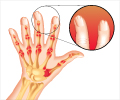Gum disease may be a key initiator of rheumatoid arthritis, new study finds. The prevalence of gum disease is increased in patients with rheumatoid arthritis and could be a key initiator of rheumatoid arthritis-related autoimmunity.

‘Gum disease is observed frequently among individuals with rheumatoid arthritis and may be a key initiator of rheumatoid arthritis-related autoimmunity.’





"It has been shown that RA-associated antibodies, such as anti-citrullinated protein antibodies, are present well before any evidence of joint disease. This suggests they originate from a site outside of the joints," said Dr Kulveer Mankia of Leeds Institute of Rheumatic and Muscoskeletal Medicine and the Leeds Biomedical Research Centre (study author). "Our study is the first to describe clinical periodontal disease and the relative abundance of periodontal bacteria in these at-risk individuals. Our results support the hypothesis that local inflammation at mucosal surfaces, such as the gums in this case, may provide the primary trigger for the systemic autoimmunity seen in RA." Rheumatoid arthritis is a chronic inflammatory disease that affects a person's joints, causing pain and disability. It can also affect internal organs. Rheumatoid arthritis is more common in older people, but there is also a high prevalence in young adults, adolescents and even children, and it affects women more frequently than men.
The prevalence of gum disease is increased in patients with RA and could be a key initiator of RA-related autoimmunity. This is because autoimmunity in RA is characterised by an antibody response to citrullinated proteins and the oral bacterium Porphyromonas gingivalis (Pg) is the only human pathogen known to express an enzyme that can generate citrullinated proteins.
"We welcome these data in presenting concepts that may enhance clinical understanding of the key initiators of rheumatoid arthritis," said Professor Robert Landewé, Chairperson of the Scientific Programme Committee, EULAR. "This is an essential step towards the ultimate goal of disease prevention."
In results from the study, dentists diagnosed clinical gum disease in significantly more at-risk individuals than in healthy controls (73% vs. 38%, p=0.02). In addition, the percentage of sites with clinical attachment level (CAL) 2mm, pocket depth (PD) 4mm, bleeding on probing (BOP), periodontal disease (PDD), and active periodontal disease (PDD+BOP), were all significantly greater in the at-risk individuals compared to controls (p<0.05). In non-smokers, PDD and active PDD were more prevalent in at-risk individuals compared to controls.
Advertisement
The study included 48 at-risk individuals (positive test for anti-citrullinated protein antibodies, musculoskeletal symptoms but no clinical synovitis), 26 patients with RA and 32 healthy controls. The three groups were balanced for age, gender and smoking. At-risk individuals underwent ultrasound assessment to assess for subclinical synovitis; only two (4%) were found to have ultrasound synovitis. Dentists examined six sites per tooth in each participant and a clinical consensus was agreed in each by three dentists.
Advertisement















